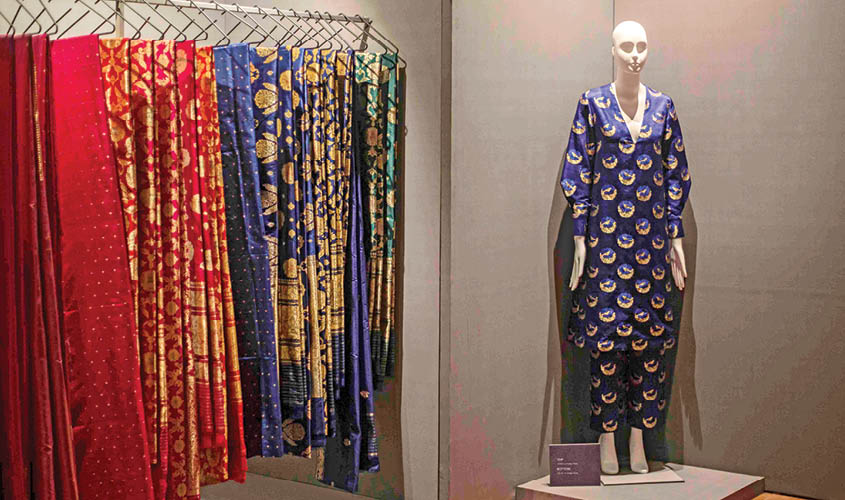In this era of fast fashion and high-end labels, there are a handful of designers who are drawing from our ancient Indian heritage, craftsmanship and reviving the rich textile traditions of India with their reinterpretations of the age-old weave.
Traditional fabrics in contemporary silhouettes have found favour with today’s generation, which is evident from the works of many popular designers. Taking up the baton to popularise traditional weaves, the indigenous textile designer Kshitij Jalori launched his label, Kshitij Jalori, on 27 July at Bikaner House, New Delhi. The inaugural event was accompanied by an exhibition of his newly-launched collection.
The collection aims to give a global vision and appeal to Indian consumers by converting regionally-sourced fabrics into beautifully stitched modern silhouettes and ensembles. Each piece showcases minimal trims, clean aesthetic and seems to be comfortable wear with well worked-out details, such as pockets and sleeves. The idea was to transform the timeless traditional handloom textiles into sophisticated, modern outfits while taking cues from the rich cultural heritage and making it more appealing to the millennial buyer.
The two-day exhibition featured Jalori’s Coromandel Colony, Pakhi Badi and Gul Bulbul lines. Each collection paid tribute to ancient traditional textiles, presenting them in a form. The designer took a total of two years and a few months more to put together all his collection.

On the making of his new collection, Jalori tells us Guardian 20, “‘Coromandel Colony’ focuses on traditional clothing as well as saris and the main techniques employed are kadwa and phekwa in the plain weave fabrics clubbed with a small selection of Mashru fabrics. I developed a very interesting fabric to make shawls for this collection—Pashmina Brocade—a fabric where fine cashmere yarns have been woven with silk and zari for a soft, smooth texture and drape. Pakhi Badi is a small capsule collection focusing on heirloom saris and dupattas and employs only kadwa technique in plain weave fabrics. Gul Bulbul is another extensive line of saris and clothing, where I have furthered the use of techniques and fabrics by using satin and plain Tanchois, Iktara fabrics along with kadwa and phekwa plain weave fabrics, as well as with Mashru.”
The designer aims to throw the spotlight back on the traditional crafts of India through his collection. He says, “Each collection has gone through the process of drawing up motifs and artworks. These artworks were then converted into graphs where weave patterns, ‘Urtu’, were designed and the shape itself was redrawn on the graph. Once the graphing was complete, the set was sent for card-cutting for the jacquard set, which was then put on the jacquard setup on the handloom and then the process of weaving began.”
The collection incorporates clean and minimalist silhouettes. Jalori has used brass hooks instead of gundi buttons for ease and wearability. The clothing has been constructed essentially keeping in mind the user-centric point of view. The collection comprises functional separates, including scarves, jackets, dresses, overcoats, pantsuits and multi-functional kurtas that can be teamed up with pants or simply be worn as dresses, along with an exquisite range of saris and dupattas from Kshitij Jalori’s classic range, which come packaged in a vintage trunk that has been developed in collaboration with fashion brand CORD.
On the colour palette, Jalori says, “Coromandel Colony has been inspired by Chintz artworks, so the collection has been designed in shades of mustard, onion pink, charcoal. Gul Bulbul has been developed in shades of old rose, indigo, earth grey and pale blue owing to its Persian influence. The line titled Pakhi Badi stays true to the romantic pastel hues that remind us of an old-world charm.”
Another veteran designer, Leena Singh launched her couture collection 2018, “Khwabeeda” on 3 August at an event in Delhi. The collection aims to revive ancient modes of design and explores contemporary and antique textile crafting weaves.

Leena, on her couture collection, says, “The collection explores contemporary forms by sustaining the indigenous craftsmanship in an amalgamation of fine details as seen in hand crafted jewelled tassels and authentic beauty of the Indian craft through fine appliqueing.”
She adds, “The unique odhnis sourced from the original wardrobes of the real Mughal Maharanis—which were restored by our skilled craftsmen—are a fusion, of yesterday and today. The journey of our odhnis is seen through unfettered jewelled colours with embroidery that begins at the hands of our skilled karigars”.
The brand AL (Ashima-Leena) has its own weavers at Varanasi, where different weaves are infused together. It took the label more than eight months to create this collection.
The collection is bedecked in rich hues of royalty, woven with intricate craftsmanship and brocades in shimmering gold and silver. The designer also talks about her colour palette. She says, “The colour palette embraces ivory and pastel pink in one collection and hues of exquisite gold dominate the entire collection. Further emulsifying to a capsule collection of black and gold, exemplary silhouettes with a hint of bottle green, plump and bronze can also be seen in this line.”
AL’s endeavour has always been to recreate the sense of Mughal royalty without relying upon the historical archive. Leena says, “Without forsaking vivacity, Ashima-Leena’s couture collection 2018 is translated through a classic aesthetic and tailored for women who are elegant, charismatic and influential. Khwabeeda is a perfect depiction of the modern maharani.”

